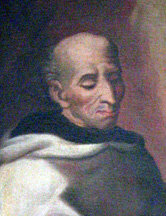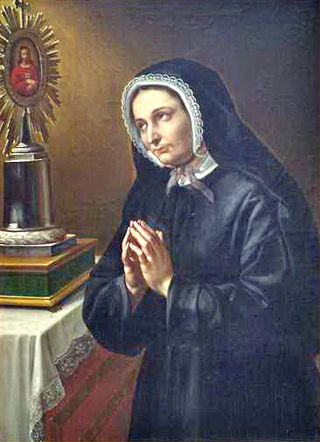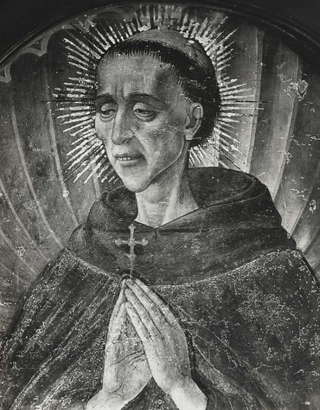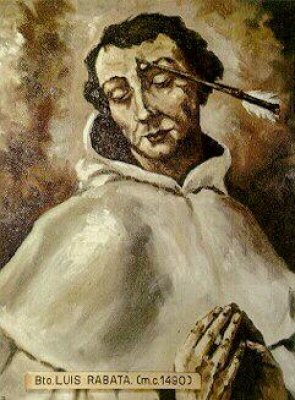Related Research Articles

Cagli is a town and comune in the province of Pesaro e Urbino, Marche, central Italy. It is c. 30 kilometres south of Urbino. The Burano flows near the town.
Giovanni Battista Righi was an Italian Roman Catholic priest and a professed member from the Order of Friars Minor. He was known for ascetic life and for his preaching and healing abilities.

Lorenzo Maria of Saint Francis Xavier – born Lorenzo Salvi – was an Italian Roman Catholic priest and a professed member of the Passionists. Salvi became friends with Gaspar del Bufalo and Bartolomeo Alberto Cappellari – future pope – during the course of his studies prior to his ordination. He was forced out of the Passionist house due to anti-clerical laws from Napoleon Bonaparte but later returned when safe to do so in order to preach and spread the charism of the Child Jesus.

Pius of Saint Aloysius was an Italian Roman Catholic professed cleric from the Passionists. He died before he could receive his ordination to the priesthood but in his short life managed to captivate people around him for his strong dedication to his order's charism and his deep faith.

Angelo Paoli, O.Carm – born Francesco – was an Italian Catholic priest and a professed member from the Carmelites. Paoli became known as the "father of the poor" due to his strong charitable outreach, for which he received praise from a number of cardinals and other prelates while living in Rome. This extended to his friend Cardinal Giuseppe Maria Tomasi and to Popes Innocent XII and Clement XI, who both offered him the cardinalate, which he refused.

Elisabetta Canori Mora was an Italian member of the Third Order of the Most Holy Trinity. Mora married an abrasive husband who remained unfaithful and abusive to her but at the time of her death secured his repentance, and he became a priest. Mora had a range of spiritual experiences in which she heard the voice of God and visions of the Madonna and other saints while also experiencing religious ecstasies during her life.

Luigi Novarese was an Italian Roman Catholic priest and the co-founder of the Apostolate of the Suffering as well as the Silent Workers of the Cross. Novarese also established the Marian Priest League and the Brothers and Sisters of the Sick; he built several homes for those who were ill and disabled. He served in the Secretariat of State until leaving that position to work alongside the Italian Episcopal Conference and to dedicate more time to the ill and to the work of his orders.

Filippo Rinaldi was an Italian Roman Catholic priest and a professed member from the Salesians of Don Bosco; he served as the third Rector Major for the order from 1922 until his death in 1931. He founded the Secular Institute of Don Bosco Volunteers. Rinaldi was close friends since his childhood to Giovanni Bosco and Paolo Albera and it was Bosco who guided Rinaldi who was torn in his adolescence between the farming life and the religious life. The order held him in high esteem from the outset and noted the potential within him as well as seeing the charism of Bosco encompassed in Rinaldi.

Domenico Lentini was an Italian Roman Catholic priest. He was ordained in 1794 and was a life-long parish priest in his hometown of Potenza where he promoted Eucharistic devotion and worked alongside the poor of the area. He also fostered education and evangelization and often taught parishioners catechism and literature while making himself available to hear the confessions of penitents.

Angelo Agostini Mazzinghi, O.Carm was an Italian Catholic priest and Carmelite friar. He was a noted preacher from Florence and was known for his pious devotion to the Carmelite Rule and to the spread of the gospel.

Giuditta Vannini – also known as Giuseppina – was an Italian Roman Catholic nun who became a Camillian. Together with Luigi Tezza she established the religious congregation known as the Daughters of Saint Camillus. She and her two siblings were orphaned as children and were placed in different homes; she was raised and educated in Rome under nuns where her vocation to the religious life was strengthened. Vannini later tried joining a religious order but was forced to leave during her novitiate period after suffering from ill health. She and Tezza met in 1891 and founded a religious congregation of which Vannini served as Superior General until her death while Tezza was exiled to Peru around 1900.

Blessed Giovanni Liccio was an Italian Roman Catholic priest and a professed member of the Order of Preachers. Liccio was a noted miracle worker and a pious preacher who was also known for his simple and ascetic manner of living. Liccio's miracles earned him the reputation of being a saint and devotion to him throughout the Sicilian cities spread.

Pietro Bonilli was an Italian Roman Catholic priest and the founder of the Sisters of the Holy Family of Spoleto. Bonilli served as a diocesan priest for his entire life in both Trevi and Spoleto while using his order to reach out to orphans and homeless people.
Giovanni Maria Boccardo was an Italian Roman Catholic priest and the founder of the Poor Daughters of Saint Cajetan. Boccardo tended to victims of a cholera epidemic in 1884 and was forced to resign all positions in his parish in 1911 due to illness that confined him to his bed. He was the elder brother of Blessed Luigi Boccardo.

Andrea Bertoni was an Italian Roman Catholic priest and a professed member of the Servite Order. Bertoni assumed the religious name of "Giacomo Filippo" upon being admitted to the Servites and he became the procurator of the convent he lived in from his appointment until his death.

Luigi Rabatà, O.Carm was an Italian Roman Catholic priest from the Order of Carmelites. He served as prior of his convent of Randazzo until his death which occurred after an attack in which an arrow was shot into his head.

Agostina Camozzi - in religious Cristina - was an Italian Roman Catholic professed religious from the Order of Saint Augustine. Camozzi led a dissolute life as a widow and a soldier's mistress before she became a nun and adopted a life of total repentance.

Domenico Spadafora was an Italian Roman Catholic priest and a professed member of the Order of Preachers. Spadafora was a noted evangelist and attracted countless to the Dominican fold while also converting the hearts of others who led dissolute lives. He is best known for being the first superior of a church he oversaw construction of in Monte Cerignone after receiving the papal approval of Pope Alexander VI to commence such work.
Giovanni de Surdis Cacciafronte was an Italian Roman Catholic priest and bishop from the Order of Saint Benedict. He served as the Bishop of Mantua from 1174 until his resignation in 1177 and held the position of Bishop of Vicenza from 1179 until his murder. The schism that Antipope Victor IV caused enabled him to proclaim his support for Pope Alexander III though leading to his removal from a position at the behest of Frederick Barbarossa.
Antonio da Stroncone was an Italian friar of the Order of Friars Minor. He became a member of that order in his youth after cultivating a strong devotion to Francis of Assisi during his childhood with his parents who were members of the Third Order of Saint Francis.
References
- 1 2 "Bl. John Saziari". Catholic Online. Retrieved 24 July 2016.
- 1 2 3 "Bl. John Saziari". Stevenwood. Retrieved 24 July 2016.
- 1 2 3 4 5 "Blessed Giovanni Saziari". Santi e Beati. Retrieved 24 July 2016.
- ↑ "Blessed John Saziari". Saints SQPN. 21 April 2012. Retrieved 24 July 2012.